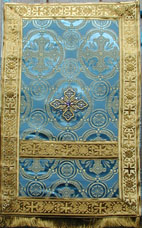Nabedrennik
This article needs additional citations for verification. (February 2013) |

A nabedrennik (Church Slavonic: набедренникъ, "on the thigh") is a vestment worn by some Russian Orthodox priests. It is a square or rectangular cloth. Like the epigonation, it is worn at the right hip, suspended from a strap attached to the two upper corners of the vestment and drawn over the left shoulder; however, if the priest also wears an epigonation, then the nabedrennik is worn at the left hip, drawn over the right shoulder.[1]
This vestment appeared in the Russian Orthodox Church in the 16th century and is unknown elsewhere. It is the only vestment worn by a priest that is not worn by a bishop and also the only that has no no associated vesting prayer.[2]
Like the epigonation, the nabedrennik is worn by certain presbyters to whom it has been awarded by a bishop "for long and dedicated service" to the church.
The rectangular shape of the nabedrennik differs from the epigonation, which is lozenge-shaped. Both are believed to derive from the ancient knee guards which shielded the legs of warriors from being bruised by their swords. The Byzantine Emperors used to award swords to their commanders and nobles; in the same way the Church awards priests who defend the faith.
References[]
- ^ Sokolof, Archpriest Dimitrii (1899), Manual of the Orthodox Church's Divine Services, Jordanville, New York: Holy Trinity Monastery (published 2001), pp. 30–31, ISBN 0-88465-067-7
- ^ The Priest's Service Book, Orthodox Church in America, Dallas, Texas: Diocese of the South, Orthodox Church in America, 2003, pp. 30–31
See also[]
- Eastern Christian vestments